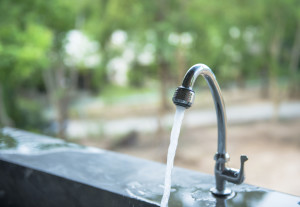What Are We Going to do When We Run Out of Water?
 As the world population grows, the consumption of water increases and shortages have started to happen. It is odd that a planet with about three quarters of its surface covered by water should have water shortages. Of course, we all know that the water in the oceans is salty and cannot be consumed by humans without serious consequences. Well, what are we going to do about it?
As the world population grows, the consumption of water increases and shortages have started to happen. It is odd that a planet with about three quarters of its surface covered by water should have water shortages. Of course, we all know that the water in the oceans is salty and cannot be consumed by humans without serious consequences. Well, what are we going to do about it?
The first thing we must do is conserve water by the elimination of leaks from water systems. The infrastructure in many cities is very old and in a state of disrepair. Wasting water because there are leaks from the water system must be reduced. Performing a system audit using flow meters located throughout the system will help locate where any leaks might be. It should be noted that some cities and states have implemented this practice
The political solution is to appoint someone to study the issue. Well, typically 5-10 years later after all the grant money has been used, the pronouncement will come that we must conserve. We knew that before the study started.
After the issue has been studied to death, the politicians will start to issue regulations to control the use of water by using government force. As water consumers, we will lose another freedom to the big government bureaucrats whose only objective in life is to stay employed.
During the last century, the rural areas of our country did not have electricity because the power companies concluded that it was not economic to provide power to rural areas. This decision was unacceptable to those people who lived in rural areas, so they formed nonprofit cooperatives to bring power to their homes and businesses. As members of the cooperative, they were also the owners. It is now time for water users to use the formation of water cooperatives to insure that they have the water to meet their needs. The cooperative organization allows the users to produce the water they need with minimal government interference. Large users such as the farmers and industry should be able to produce the water quality they need while a smaller part of the plant could also produce potable water.
Using existing technology such as reverse osmosis and fixed bed deionization, seawater can be purified enough for human consumption. The plant would use seawater from the ocean or gulf as feed and return the brackish byproduct water to the sea. The nice thing about this technology is that it is easily scaled up or down to the water demand. It should be noted that technology similar to this is currently being used to provide water in the Middle East. If seawater is treated, the government would most likely be involved in the plant site selection and where and how the seawater would be collected and the brackish wastewater discharged back into the sea.
Multistage evaporation could also be used if large quantities of waste heat were available. In this case the equipment would be much larger, more costly and the turndown to lower rates more difficult.
Once the water has been produced, it must be stored and shipped from the plant to the user. The cheapest way would probably be to use a pipeline to a distribution point from which the final user could receive his water. Alternately, the water could be transported by truck or train.
For agriculture and fracking uses, the quantities needed could be quite large. For instance, it takes about two million gallons of water to cover a 100 acre site with water to a depth of about ¾ inch. Fracking operations typically need from one to six million gallons of water.
The user would have to store this water in closed containers because open air storage could lose half of the volume stored due to evaporation. These operations would very likely need large storage capacities on both ends. Bladder tanks storing 150,000 gallons are available now. It should be noticed that if bladder tanks were used for storage, runoff from spring rains could be pumped into these tanks for future use.
Recently in Texas a rice farmer who has the right to pump from the local aquifer pumped it dry leaving his neighbors with no water. While this is legal now, it does not take a genius to note that this will probably not be allowed in the future. Restrictions will be placed on the farmer and these restrictions could cause him to go out of business. The time to produce potable water using sea water feed is now before the government restrictions are put in place. Government is almost always reactive instead of being proactive. They react to a crisis instead of preventing a crisis.
Bottom line is that food costs for everyone will go up when water must be produced to produce food. The alternative option is no food or less food. There are no free lunches.
Once again, the time to start using existing technology to treat massive quantities of seawater to meet the country’s water needs is NOW and the vehicle to do this are privately owned water cooperatives.
